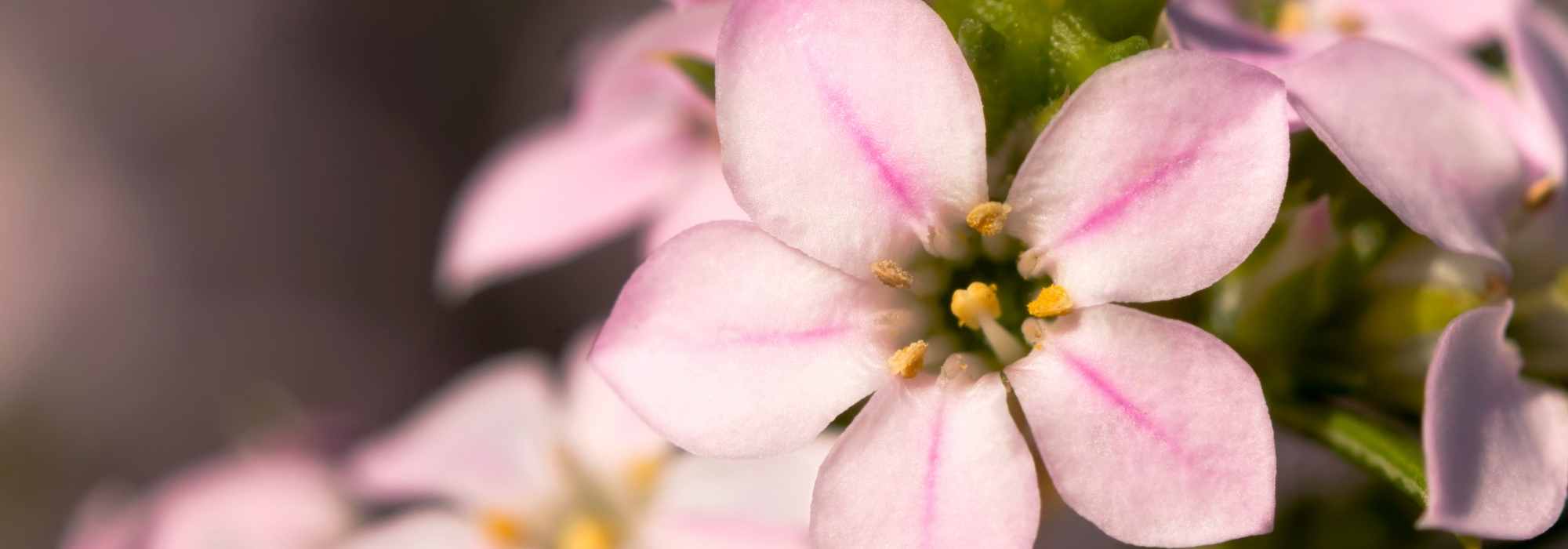
Diosma hirsuta: planting, growing, and care
Contents
Diosma hirsuta in a word
- Diosma is an undershrub that is among the first plants to flower in late winter.
- It forms a small dense bush resembling heather, not exceeding 50 cm in height.
- Its highly aromatic foliage when crushed is topped with an early starry flowering, either white or pink.
- Frost-sensitive, it is only grown in open ground in mild climates; elsewhere, it will thrive in a pot that can be brought indoors in winter.
- It is a perfect plant for a dry rockery, a gravel border, or a seaside garden.
A word from our expert
Diosma hirsuta, the hairy diosma, also known as the “fisherman’s plant”, is a South African undershrub valued for its particularly aromatic foliage that releases fragrance with the slightest touch, topped with an early spring flowering of white or pink that lasts until June. It forms a lovely small bush typical of southern regions, not exceeding 50 cm in height, very bushy, nicely rounded, and compact, with evergreen foliage reminiscent of heather. You can choose from beautiful varieties such as Diosma hirsuta ‘Pink Fountain’ or ‘Sunset Gold’ with its very bright golden-green foliage.
Drought-tolerant once well-rooted, it is a beautiful plant for poor soil, very useful for enhancing the decor of a dry garden or a large rockery, but only in our mildest regions. Frost-sensitive at -5 °C, this delicate plant can only be grown in the ground along the Mediterranean coast or in mild oceanic climates. Elsewhere, it will thrive in a pot or bowl to be sheltered in winter, adorning the terrace or balcony.
Plant it after the last frosts. It loves full sun, warmth, and is very well adapted to dry, poor soils.
Make room in the sun for this tightly packed cushion of carefully shaped foliage!
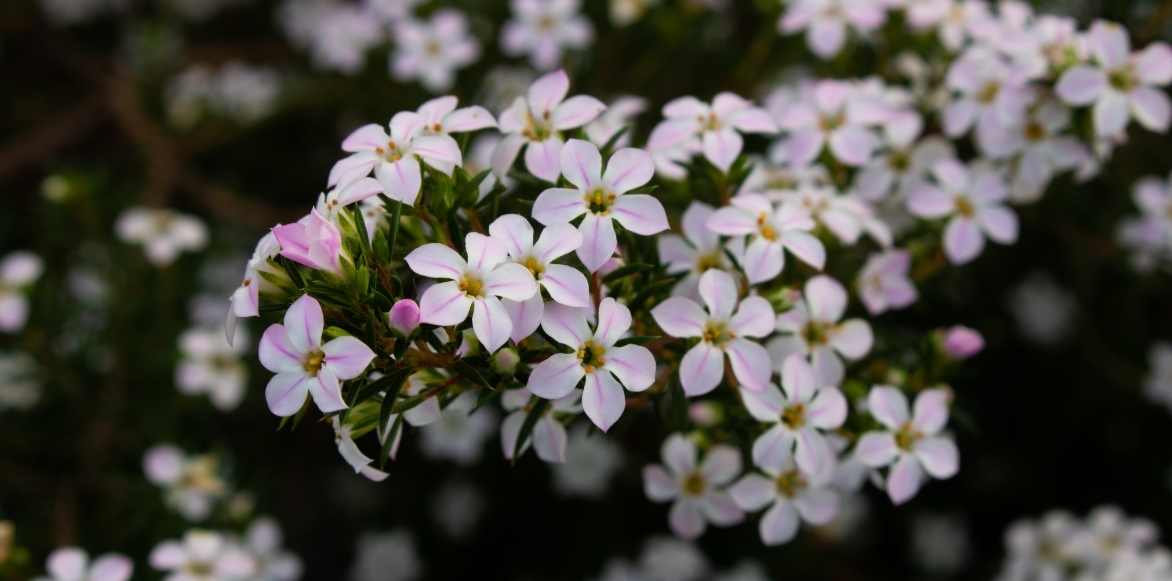
Diosma hirsuta
Description and botany
“`html
Botanical data
- Latin name Diosma hirsuta
- Family Rutaceae
- Common name Hirsute Diosma, breath of heaven
- Flowering March to June
- Height 0.40 to 0.60 m
- Exposure Sun
- Soil type poor and well-draining
- Hardiness frost-sensitive to -5°C
Diosma or Hirsute Diosma is a shrub native to the Cape region of South Africa, belonging to the Rutaceae family, just like lemon trees. In its natural habitat, it grows on slopes with sandy or clayey soil, at medium altitudes. From its African origins, it has retained a certain sensitivity to cold. The Diosma is a semi-hardy plant that cannot withstand winter temperatures dropping below -5°C. In our regions, it is only cultivated in open ground in Mediterranean areas or mild oceanic climates, such as in a seaside garden.
The genus Diosma comprises about 30 species, among which Diosma hirsuta, the “hirsute diosma”, is the only one represented in our gardens. This species has produced some interesting cultivars whose flowering ranges from white to red, and whose foliage colour also varies, such as ‘Pink Fountain’ and ‘Sunset Gold’.
This woody shrub forms a very small, bushy tree with a single trunk. It has a dense habit, most often naturally rounded and slightly spreading. It will not exceed 40-60 cm in height and 50-60 cm in spread, with a slow growth rate. Its woody stems root very easily upon contact with the soil, allowing it to form beautiful cushions.
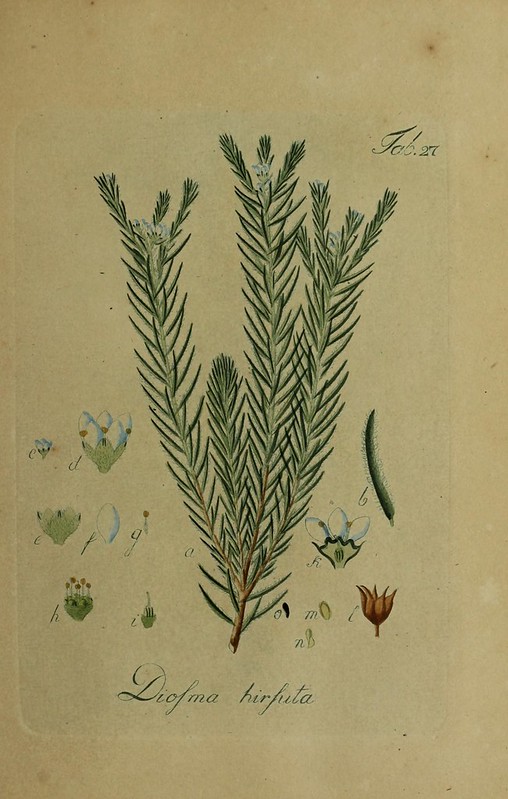
Diosma hirsuta: botanical plate from 1819 – Biodiversity Heritage Library
The flexible stems bear fine, evergreen foliage reminiscent of heather or a small cypress. The leaves are alternate, very thin, measuring 7 to 10 mm in length, sessile, without petioles, and upright. They are finely villous, hence the Latin qualifier “hirsuta”. The plant is highly fragrant when its leafy branches are crushed. This foliage exudes a surprising spicy and lemony scent. A strong odour that has earned Diosma hirsuta the nickname “fisherman’s plant”, referring to fishermen who rubbed their hands on this highly aromatic foliage to attenuate the smell of fish. “Diosma” etymologically means “fragrance of the gods”, which foretells the aromatic qualities of the plant!
The foliage varies according to the varieties. Fresh and tender green in ‘Pink Fountain’, blue-green in ‘Blue Downs’, very bright anise-green in ‘Sunset Gold’, it is variegated in ‘Variegata’.
From this compact bush emerges an early and remarkably long spring flowering. It begins, depending on the climate, in February-March, extending until June-July. The flowers are either solitary or grouped in clusters at the tips of the stems. Each consists of 5 petals united in a star-shaped corolla around 5 visible stamens. They are tiny, measuring no more than 5 to 7 mm in diameter, but are countless.
Their colours are very romantic: pure white or slightly tinged with pale pink or bright pink, sometimes red at the end of flowering.
This multitude of small nectariferous flowers renews itself continuously for about 4 months. Once fertilised, they are followed by the formation of small green fruits, also aromatic, containing 5 shiny black seeds.
“`
Main varieties
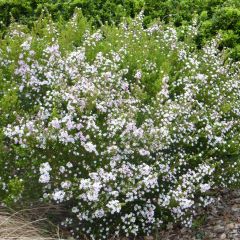
Diosma hirsuta Pink Fountain
- Période de floraison April to July
- Hauteur à maturité 45 cm
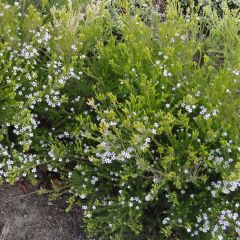
Diosma hirsuta Sunset Gold
- Période de floraison April to July
- Hauteur à maturité 40 cm
Planting
Where to plant it?
Naturally growing on the sandy slopes of South Africa, this undershrub is sensitive to cold, frost-tender down to -5 °C. It is an ideal plant for mild climates in winter, and dry, hot conditions in summer. Once well established, it tolerates drought perfectly and also copes well with sea spray. The Diosma hirsuta is only grown in open ground in coastal and Mediterranean gardens. Position it in the warmest corner of the garden, in full sun against a south-facing wall, for example. Elsewhere, particularly in colder and wetter regions, it should be grown in a pot to protect it during winter. It loves full sun and warmth, which will enhance its fragrance.
It adapts to all types of soil, provided it is very well-drained and does not retain water. A loose, slightly stony or sandy soil, slightly acidic, neutral, or even a bit calcareous will remind it of its origins.
It is a boon for poor soils where it forms lovely clumps of evergreen foliage throughout the year in large rockeries, in borders, or to edge a bed or bank composed of garrigue or scrub vegetation plants. It can also be grown in pots or bowls on the terrace or balcony, adding a Mediterranean charm. In most of our regions, you can also grow it year-round as a conservatory plant in a greenhouse or a lightly heated conservatory.
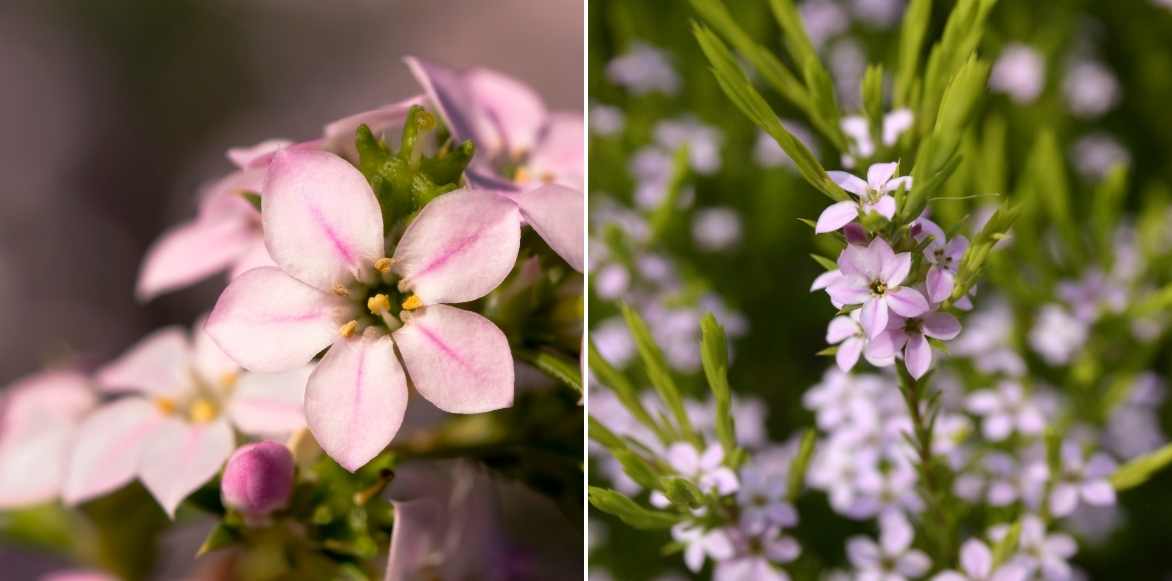
The delicate flowering of Diosma hirsuta
When to plant Diosma hirsuta?
Diosma hirsuta should be planted in spring, in March-April, after the frost when temperatures have warmed sufficiently.
How to plant it?
In open ground
In heavy or clayey soil, incorporate gravel or coarse sand at the bottom of the planting hole. One plant per square metre is sufficient; ensure it has enough space to avoid being smothered by neighbouring plants.
- Dig a hole with a diameter twice that of the root ball
- Spread a layer of gravel or clay balls at the bottom of the hole
- Plant in the middle of the planting hole, then fill in with a mix of 1/2 garden soil, 1/4 potting soil or compost, and 1/4 sand
- Do not bury the collar
- Lightly firm the soil
- Water well at planting
In a pot
This is a small-growing bush that is perfectly suited for pot cultivation. The substrate must be light and very well-drained to prevent root rot. Improve drainage with gravel, coarse sand, or simply pebbles.
- At the bottom of a container of at least 3 or 5 litres, spread a good layer of gravel or clay balls
- Plant without burying the collar in a mix of 1/3 leaf mould or heather soil, 1/3 sand, and 1/3 well-rotted compost
- Water at planting
Read also
15 plants for a sunny rockeryMaintenance, pruning and care
Diosma hirsuta is a truly low-maintenance plant that never gets sick as long as the soil remains well-drained.
Water in the first summer following planting: this is essential to encourage rooting. Provide light but regular watering without allowing the soil to dry out too much between waterings and without flooding the roots. Once well established, it will easily withstand the long, dry summers characteristic of the Mediterranean climate, requiring no watering during the hot period.
In pots, add a little slow-release fertiliser at the end of winter and every 3 weeks to support flowering. Ensure more frequent watering while always allowing the substrate to dry out between waterings.
In the northern regions of the Loire, protect it from the cold with a thick mulch and wrap the aerial parts with fleece. Bring your pots indoors before the first frosts, in a bright but unheated room. You can take your Diosma hirsuta outside again in the beautiful season.
After flowering, lightly prune the spent stems with pruning shears to encourage the plant to branch out and maintain a compact habit.
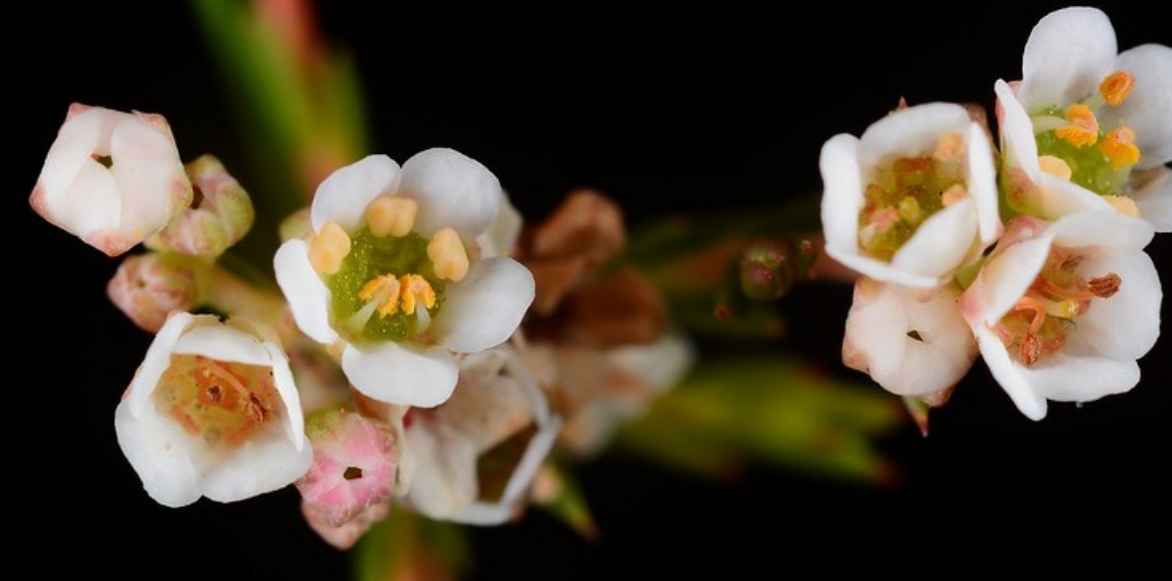
Diosma hirsuta (© Galanhsnu)
Multiplication
The Diosma hirsuta is easily propagated by layering in spring. Sowing in spring with seeds from the previous year or with commercial seeds also yields good results.
By layering
Layering is done in spring on flexible shoots.
- Incline low branches towards the ground
- Remove the leaves from the lower part of the stems
- Make a cut in the bark about 3 to 5 cm from the tip of the shoots
- Buried part for rooting by covering with potting soil and sand
- Secure the layers in the soil with a metal hook (U-shaped or sardine type)
- After 4 to 6 weeks, using pruning shears, you can separate the layer from the mother plant
- Transplant immediately to the garden or into pots
Sowing
You will need to wait until the second year after sowing to see your plants flower.
- In March, sow the seeds broadcast in trays filled with good potting soil
- Cover with a thin layer of sand
- Water to keep the substrate moist but not waterlogged until germination
- Keep under heated shelter and in light
- Transplant the young seedlings into pots
- Place in the garden in their final position or in pots as soon as rooting is sufficient
Associating
Diosma hirsuta is a plant for mild climates, perfect for a dry rockery, a gravel bed, or a seaside garden as it is not afraid of sea spray. This undershrub is a good plant for dry soils. In rockeries, it pairs perfectly with drought-resistant perennials and Mediterranean perennials reminiscent of garrigue, such as cistus, rosemary, lavender, thyme, helianthemums, wormwoods, and small potentillas, along with a Santolina ‘Edward Bowles’ with white flowers.
In early spring, it will accompany the early blooms of certain bulbous plants like crocuses or Iris reticula. It makes a good companion for Thym praecox ‘Purple Beauty’, Erysimum ‘Jenny Brook’ wallflowers, as well as groundcovers for dry soils such as Erigeron karvinskianus. Add verticality to the display with Iris germanica!
It will form small, long-flowering cushions at the foot of buddleias and Mediterranean shrubs like creeping broom and mimosa.
In a small evergreen hedge, pair it with ceanothus shrubs (‘Italian Skies’, ‘Concha’, ‘Skylark’…), Leptospermum, Pittosporum tobira ‘nanum’, or white-flowering callistemons (Callistemon citrinus ‘Albus’).
When grown in a conservatory, it will create a beautiful scene all year round alongside an orange tree, a Boronia heterophylla, or a mimosa.
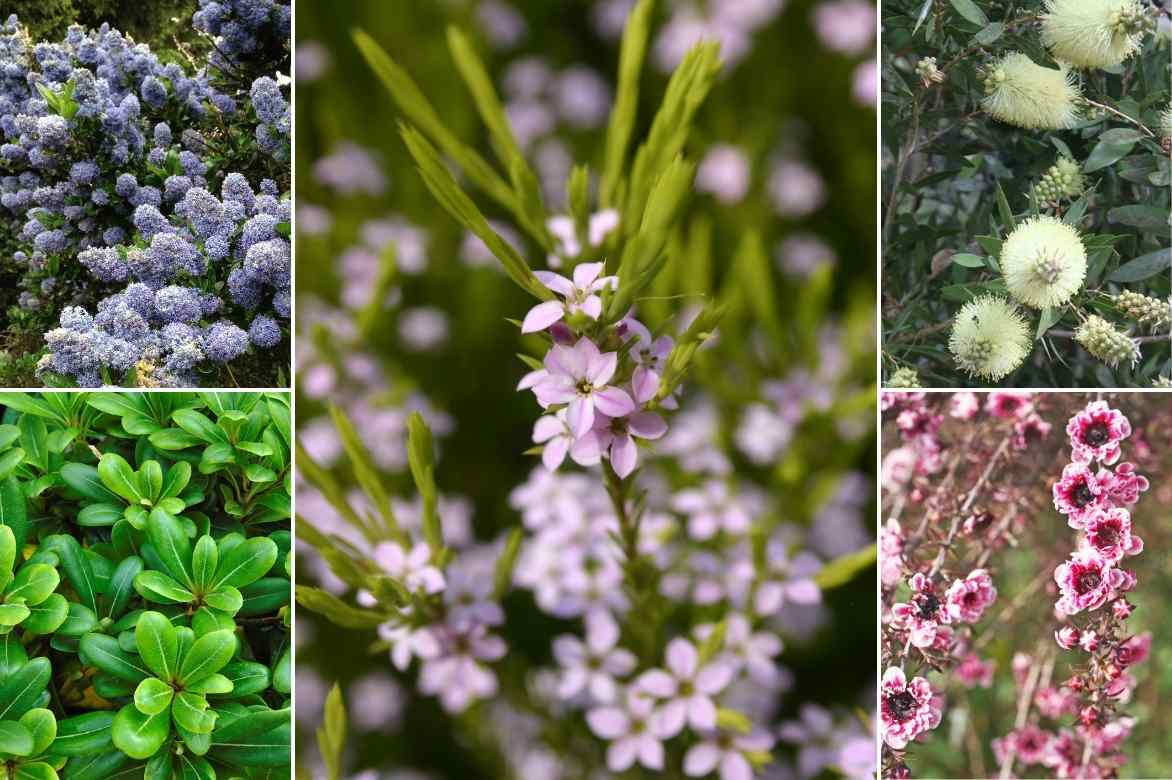
An association of Diosma in a small shrub hedge with a ceanothus, a Pittosporum tobira ‘Nanum’, a Callistemon citrinus ‘Albus’, and a Leptospermum scoparium
Useful resources
- Here is a small selection of drought-resistant perennials, perfect for a garden without watering!
- What plants for a sunny natural garden?
- Discover Elizabeth’s Mediterranean garden!
- Subscribe!
- Contents































Comments